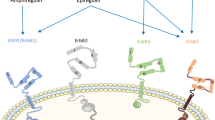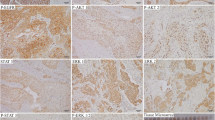Abstract.
The epidermal growth factor receptor family consists of four closely related transmembrane receptors: epidermal growth factor receptor (EGF-R), c-erbB-2, c-erbB-3, and c-erbB-4. Overexpression of each receptor may lead to cell transformation and contributes to tumor progression in various malignancies. Although these factors have been analyzed in many cancers separately, little is known about their concomitant expression in esophageal cancer. Based on the finding that EGF-R and c-erbB-2 form highly active transmembranous heterodimers that enhance cell growth and proliferation, we used Northern blot analysis and immunohistochemistry to analyze the concomitant expression of EGF-R, c-erbB-2, and c-erbB-3 in tissue samples obtained from 39 patients undergoing esophagectomy for esophageal cancer. Northern blot analysis revealed a fourfold increase (p < 0.01) in EGF-R mRNA levels in the esophageal cancer samples in comparison with normal tissue samples. The c-erbB-2 receptor was only 1.25-fold elevated in the esophageal cancers, which failed to be statistically significant (p= 0.31). In contrast, c-erbB-3 mRNA levels were 3.5-fold lower (p < 0.01) in the esophageal cancers than in the normal tissues. Immunohistochemical analysis showed weak EGF-R, c-erbB-2, and c-erbB-3 immunostaining in the normal esophageal tissue. In esophageal cancer samples, immunoreactivity for EGF-R, c-erbB-2, and c-erbB-3 was mainly located in the cancer cells. Strong EGF-R, c-erbB-2, and c-erbB-3 immunoreactivity was present in 59%, 64%, and 64% of the esophageal cancer samples, respectively. In consecutive tissue sections, identical cancer cell clusters often exhibited these three closely related receptors simultaneously. However, correlation of the immunohistochemical findings with the clinicopathologic patient parameters revealed that the presence of EGF-R, c-erbB-2, or c-erbB-3 had no influence on patient survival (p > 0.05). In addition, the simultaneous presence of these receptors did not influence survival. Our findings indicate that in esophageal cancer the presence of EGF-R, c-erbB-2, and c-erbB-3 alone or in combination seems to have no major influence on patient prognosis and does not alter tumor growth behavior significantly.
Similar content being viewed by others
Author information
Authors and Affiliations
Rights and permissions
About this article
Cite this article
Friess, H., Fukuda, A., Tang, WH. et al. Concomitant Analysis of the Epidermal Growth Factor Receptor Family in Esophageal Cancer: Overexpression of Epidermal Growth Factor Receptor mRNA but Not of c-erbB-2 and c-erbB-3 . World J. Surg. 23, 1010–1018 (1999). https://doi.org/10.1007/s002689900616
Published:
Issue Date:
DOI: https://doi.org/10.1007/s002689900616




